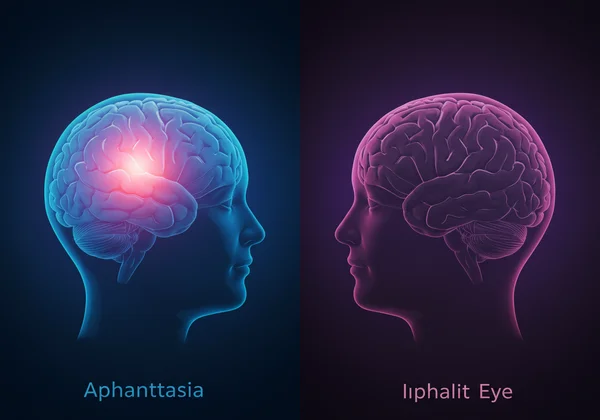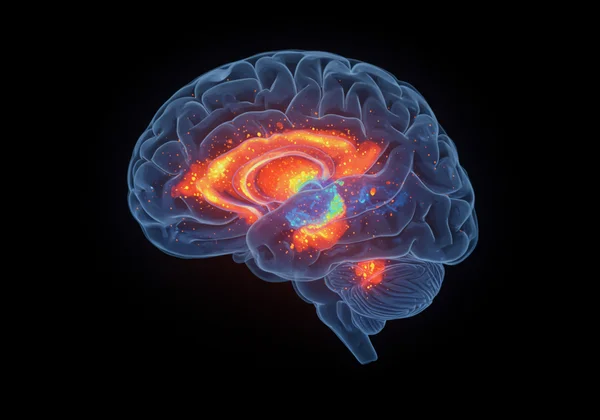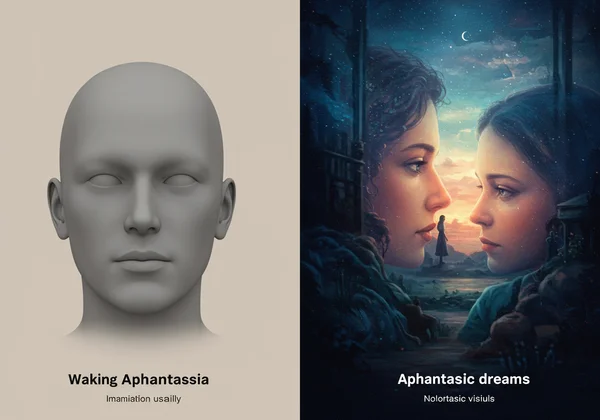अफांटेशिया और सपने: क्या अफांटेशिया वाले लोग भी सपने देखते हैं? हमारा टेस्ट लें
क्या आपने कभी सोचा है कि जब कोई व्यक्ति सोता है और छवियों की कल्पना नहीं कर पाता, तो उसके मन में क्या होता है? अफांटेशिया, या स्वेच्छा से मानसिक चित्र बनाने में असमर्थता वाले व्यक्तियों के लिए, मानसिक चित्रण की अवधारणा ही अमूर्त है। यह स्वाभाविक रूप से हमें एक दिलचस्प सवाल की ओर ले जाता है जिस पर आप विचार कर रहे होंगे: अफांटेशिया वाले लोग कैसे सपने देखते हैं? यदि जागृत मन दृश्य कल्पना के प्रति अंधा है, तो क्या सपने देखने वाला मन अलग तरह से काम करता है? यह लेख अफांटेशिया के सपनों की पेचीदा दुनिया में गहराई से उतरता है, यह पता लगाता है कि अवचेतन मन एक दृश्य कैनवास के बिना अनुभवों को कैसे गढ़ता है। हम सपने देखने के बारे में पारंपरिक विचारों को चुनौती देंगे और अवचेतन की समृद्ध, बहु-संवेदी प्रकृति को उजागर करेंगे। यदि आप यह जानने के लिए उत्सुक हैं कि आप दृश्यीकरण स्पेक्ट्रम पर कहाँ आते हैं, तो एक त्वरित और विश्वसनीय अफांटेशिया टेस्ट मूल्यवान अंतर्दृष्टि प्रदान कर सकता है, या आप अपनी कल्पना शक्ति को परखें।

अफांटेशिया और मन की आँख को समझना
इससे पहले कि हम सपनों के परिदृश्य का अन्वेषण करें, इस अद्वितीय संज्ञानात्मक विशेषता की नींव को समझना महत्वपूर्ण है। अफांटेशिया कोई विकार नहीं है, बल्कि मानवीय अनुभव में एक भिन्नता है, जो लाखों लोगों को प्रभावित करती है जिन्हें शायद यह भी पता न हो कि उनका दिमाग अलग तरह से काम करता है। इस अवधारणा को समझना मानवीय चेतना की विविधता को समझने का पहला कदम है।
वास्तव में अफांटेशिया क्या है? एक संक्षिप्त अवलोकन
अफांटेशिया एक स्वैच्छिक मानसिक दृश्य कार्यशाला का अभाव है। जब एक सेब की कल्पना करने के लिए कहा जाता है, तो अधिकांश लोग विभिन्न डिग्री की स्पष्टता के साथ एक मानसिक छवि बना सकते हैं। अफांटेशिया में व्यक्ति स्वेच्छा से मानसिक चित्र नहीं बना पाता। वे जानते हैं कि सेब क्या है, उसका रंग और आकार बता सकते हैं, लेकिन वे उसे अपने मन में देखते नहीं हैं। उनकी विचार प्रक्रिया को अक्सर वैचारिक, मौखिक या संवेदी के रूप में वर्णित किया जाता है, जो चित्रों के बजाय तथ्यों और भावनाओं पर निर्भर करती है। यह अद्वितीय संज्ञानात्मक शैली उनके याद रखने, सीखने और, जैसा कि हम देखेंगे, सपने देखने के तरीके को आकार देती है। अपनी अनूठी संज्ञानात्मक प्रोफ़ाइल को सही मायने में समझने के लिए, एक अफांटेशिया टेस्ट अविश्वसनीय रूप से ज्ञानवर्धक हो सकता है, जो स्वैच्छिक मानसिक कल्पना को अलग करता है।
दृश्य कल्पना का स्पेक्ट्रम: हाइपरफांटेशिया से अफांटेशिया तक
मानसिक कल्पना कोई ऑन-या-ऑफ स्विच नहीं है। यह एक विशाल स्पेक्ट्रम पर मौजूद है। एक छोर पर हाइपरफांटेशिया है, जहाँ व्यक्ति मानसिक कल्पना का अनुभव करते हैं जो वास्तविक जीवन जितनी ही ज्वलंत और विस्तृत होती है। विपरीत छोर पर अफांटेशिया है, जो दृश्यीकरण की पूर्ण कमी है। अधिकांश लोग बीच में कहीं आते हैं, जिसमें उनके मानसिक चित्रों की स्पष्टता और नियंत्रण के विभिन्न स्तर होते हैं। इस स्पेक्ट्रम को पहचानने से हमें यह समझने में मदद मिलती है कि सोचने का कोई "सामान्य" तरीका नहीं है। यदि आप अपनी दृश्यीकरण क्षमता के बारे में सोच रहे हैं, तो एक विज्ञान-समर्थित अफांटेशिया टेस्ट, जैसे कि ऑनलाइन वीवीआईक्यू टेस्ट में पाया गया, मूल्यवान अंतर्दृष्टि प्रदान कर सकता है।
क्या अफांटेशिया वाले लोग सपने देखते हैं? अनुभव को उजागर करना
संक्षिप्त उत्तर एक जोरदार हाँ है। हालांकि, अफांटेशिया के साथ सपने देखने का अनुभव अक्सर दृश्यीकरण करने वालों की अपेक्षा से काफी अलग होता है। मानसिक फिल्मों के लिए एक स्क्रीन के बिना, मस्तिष्क अपनी रात की कहानियों को बनाने के लिए अन्य इंद्रियों और प्रणालियों का उपयोग करता है, जिससे गैर-दृश्य अनुभवों की एक समृद्ध टेपेस्ट्री बनती है। जबकि यह आकर्षक है, किसी के सपने के अनुभव को निर्धारित करना अक्सर एक समर्पित अफांटेशिया टेस्ट के माध्यम से उनकी जागृत दृश्यीकरण क्षमताओं को समझने से शुरू होता है।
सामान्य अफांटासिक स्वप्न परिदृश्य: संवेदी और वैचारिक
अफांटेशिया वाले कई लोगों के लिए, सपने देखे नहीं जाते बल्कि जाने जाते हैं। वे अवधारणाओं, विचारों और भावनाओं के संग्रह के रूप में सामने आते हैं। एक अफांटासिक व्यक्ति सपना देख सकता है कि वह एक समुद्र तट पर है और "जानता" है कि आकाश नीला है और सूरज डूब रहा है, बिना वास्तव में रंगों को देखे। सपना तथ्यों की जागरूकता और स्थानिक उपस्थिति की एक मजबूत भावना से बनता है। यह अक्सर एक समृद्ध संवेदी अनुभव के साथ होता है जिसमें दृष्टि शामिल नहीं होती है। वे सूरज की गर्मी महसूस कर सकते हैं, लहरों के टकराने की आवाज सुन सकते हैं, और नमकीन हवा सूंघ सकते हैं, यह सब अविश्वसनीय स्पष्टता के साथ।

दृश्यों से परे: गैर-दृश्य सपने कैसे प्रकट होते हैं
मस्तिष्क एक अद्भुत अनुकूलक है। दृश्य डेटा की अनुपस्थिति में, सपनों में अन्य इंद्रियाँ अक्सर तेज हो जाती हैं। श्रवण विवरण अविश्वसनीय रूप से स्पष्ट हो सकते हैं, भावनात्मक अवस्थाएँ तीव्र रूप से वास्तविक महसूस हो सकती हैं, और शारीरिक संवेदनाएँ शक्तिशाली हो सकती हैं। अफांटेशिया वाले कई लोग ऐसे सपनों की रिपोर्ट करते हैं जो भारी संवाद-आधारित होते हैं, लगभग एक रेडियो नाटक सुनने जैसा। अन्य अपने सपनों को विशुद्ध रूप से भावनात्मक या काइनेस्थेटिक के रूप में वर्णित करते हैं, जहाँ पूरा अनुभव भावनाओं और आंदोलन द्वारा परिभाषित होता है। अपनी अनूठी संज्ञानात्मक प्रोफ़ाइल को समझने की तलाश करने वालों के लिए, एक अफांटेशिया टेस्ट लेना एक मूलभूत कदम है, जो व्यक्तिगत अनुभवों पर स्पष्टता प्रदान करता है। आप आज ही अपना मूल्यांकन शुरू कर सकते हैं।
अफांटेशिया से जुड़े सपनों के पीछे का विज्ञान
जबकि व्यक्तिगत खाते आकर्षक अंतर्दृष्टि प्रदान करते हैं, विज्ञान मस्तिष्क में क्या हो रहा है, इसकी गहरी जानकारी प्रदान करता है। अफांटेशिया से जुड़े सपनों की घटना संज्ञानात्मक तंत्रिका विज्ञान में बढ़ती रुचि का क्षेत्र है, जो चेतना, स्मृति और नींद के बीच जटिल संबंध पर प्रकाश डालती है। वैज्ञानिक समुदाय अक्सर अफांटेशिया टेस्ट के समान तरीकों पर निर्भर करता है ताकि दृश्यीकरण क्षमताओं को वर्गीकृत और अध्ययन किया जा सके, मस्तिष्क की गतिविधि को सचेत अनुभव से जोड़ा जा सके।
नींद के चरण और अफांटेशिया में मस्तिष्क की गतिविधि
सपने मुख्य रूप से नींद के रैपिड आई मूवमेंट (आरईएम) चरण के दौरान आते हैं। आरईएम के दौरान, मस्तिष्क अत्यधिक सक्रिय होता है, यादों को समेकित करता है और भावनाओं को संसाधित करता है। मस्तिष्क इमेजिंग अध्ययन बताते हैं कि दृश्य प्रांतस्था - मस्तिष्क का वह हिस्सा जो दृष्टि को संसाधित करता है - अफांटेशिया वाले लोगों में भी आरईएम नींद के दौरान सक्रिय होता है। इससे एक सम्मोहक सिद्धांत सामने आया है: मस्तिष्क अभी भी दृश्य जानकारी उत्पन्न कर रहा होगा, लेकिन एक अफांटासिक व्यक्ति के सचेत मन में इसे व्याख्या करने या "देखने" का तंत्र नहीं होता है। डेटा तो मौजूद है, लेकिन मॉनिटर बंद है। यह दर्शाता है कि नींद के दौरान मस्तिष्क की गतिविधि कितनी जटिल होती है।

स्पष्ट सपने देखना और अफांटेशिया: क्या दृश्य नियंत्रण संभव है?
स्पष्ट सपने देखना - यह जानने का कार्य कि आप सपना देख रहे हैं - एक और दिलचस्प पहलू जोड़ता है। कुछ अफांटासिक्स जो स्पष्ट सपने देखते हैं, वे दृश्यों को उत्पन्न करने में असमर्थता की रिपोर्ट करते हैं, तब भी जब वे सपने के कथानक के सचेत नियंत्रण में होते हैं। वे उड़ने का फैसला कर सकते हैं, लेकिन वे केवल उड़ने की सनसनी महसूस करते हैं, बिना नीचे की जमीन को देखे। हालांकि, व्यक्तियों का एक छोटा उपसमूह सपनों में धुंधले, क्षणिक, या अनियंत्रित दृश्यों की रिपोर्ट करता है, जो उनके जागृत होने पर कल्पना की पूर्ण कमी के विपरीत है। यह बताता है कि सचेत और अवचेतन दृश्यीकरण के बीच की बाधा हमेशा पूर्ण नहीं होती है। इन व्यक्तिगत बारीकियों की खोज अक्सर एक व्यापक अफांटेशिया टेस्ट से शुरू होती है, जो व्यक्तियों को उनकी अनूठी दृश्यीकरण प्रवृत्तियों को इंगित करने में मदद करती है। एक ऑनलाइन अफांटेशिया टेस्ट इन व्यक्तिगत बारीकियों को समझने का पहला कदम हो सकता है।
भिन्नताओं का अन्वेषण: सपनों में दृश्यीकरण बनाम जागृत जीवन
अफांटेशिया और सपनों के सबसे उलझाने वाले पहलुओं में से एक असंगति है। कुछ लोग जो जागृत रहते हुए पूरी तरह से अफांटासिक होते हैं, वे ज्वलंत दृश्य सपने देखने की रिपोर्ट करते हैं। यह विरोधाभास स्वैच्छिक और अनैच्छिक कल्पना को नियंत्रित करने वाले विभिन्न तंत्रिका मार्गों पर प्रकाश डालता है, यह सुझाव देता है कि सपनों में दृश्यीकरण एक अलग प्रणाली पर काम करता है।
जागृत कल्पना से स्वप्न कल्पना क्यों भिन्न हो सकती है
जागृत मन स्वैच्छिक स्मरण पर निर्भर करता है, एक टॉप-डाउन प्रक्रिया जहाँ आप जानबूझकर एक छवि को पुनः प्राप्त करने का प्रयास करते हैं। हालांकि, सपने देखना एक बॉटम-अप प्रक्रिया है। आरईएम नींद के दौरान, ब्रेनस्टेम कॉर्टेक्स को यादृच्छिक संकेत भेजता है, जो तब इन संकेतों को एक सुसंगत कहानी में संश्लेषित करने का प्रयास करता है। यह अनैच्छिक, अराजक प्रक्रिया दृश्य मार्गों को इस तरह से सक्रिय कर सकती है जो सचेत प्रयास नहीं कर सकता है। यह ऐसा है जैसे मस्तिष्क का स्वचालित "कहानी सुनाने का तरीका" उस अवरोध को बायपास कर सकता है जो जानबूझकर दृश्यीकरण को प्रभावित करता है। मन के इस अनूठे पहलू को अफांटेशिया टेस्ट लेकर स्पष्ट किया जा सकता है, जो जागृत और स्वप्न दृश्यीकरण के बीच अंतर करता है। यह पता लगाना कि क्या यह आप पर लागू होता है, एक साधारण अफांटेशिया स्व-मूल्यांकन से शुरू होता है।
उपाख्यानात्मक साक्ष्य: अफांटासिक स्वप्नदर्शियों की वास्तविक कहानियाँ
अनुभव को सही मायने में समझने के लिए, अफांटासिक्स से सुनना अमूल्य है। ऑनलाइन समुदाय कहानियों से भरे हैं। एक व्यक्ति ने अपने सपने का वर्णन किया, "एक फिल्म की कहानी जानने जैसा, बिना कभी स्क्रीन देखे।" दूसरे ने साझा किया, "मेरे सपने सिर्फ मेरी आंतरिक एकालाप हैं जिसमें भावनाएँ और ध्वनियाँ शामिल हैं। मैं जानता हूँ कि क्या हो रहा है, लेकिन कोई चित्र नहीं हैं।" फिर भी एक और ने आश्चर्य व्यक्त किया: "मैं जागते हुए अपनी माँ का चेहरा नहीं देख सकता, लेकिन कल रात मैंने उसे पूरी विस्तार से सपने में देखा।" ये कहानियाँ इस बात पर जोर देती हैं कि अफांटेशिया कोई एकरूप नहीं है; यह एक व्यक्तिगत और विविध अनुभव है, जिसे अक्सर एक सुलभ अफांटेशिया टेस्ट के माध्यम से शुरू में पहचाना जाता है।

अपने अद्वितीय अवचेतन मन का अनावरण: अपने स्वप्न अनुभव को गले लगाओ
अफांटासिक सपनों की दुनिया यह बताती है कि दृश्यीकरण मन द्वारा अनुभव बनाने के लिए उपयोग किए जाने वाले कई उपकरणों में से एक है। चाहे आपके सपने वैचारिक स्क्रिप्ट हों, संवेदी सिम्फनी हों, या अप्रत्याशित दृश्य चमक हों, वे आपकी संज्ञानात्मक पहचान का एक वैध और पूर्ण हिस्सा हैं। सपने देखने का कोई सही या गलत तरीका नहीं है, जैसे सोचने का कोई सही या गलत तरीका नहीं है।
आत्म-खोज की यह यात्रा आपको यह समझने में वास्तविक स्पष्टता ला सकती है कि आप कैसे सीखते हैं, याद रखते हैं और यहां तक कि सपने भी देखते हैं। क्या हमारी खोज ने आपके संज्ञानात्मक परिदृश्य के बारे में आपकी जिज्ञासा जगाई है? तो आपका अगला कदम सरल है: एक सटीक अफांटेशिया टेस्ट आपकी आंतरिक दुनिया की गहरी समझ को अनलॉक कर सकता है। शुरू करने के लिए तैयार हैं? हमारा मुफ्त अफांटेशिया टेस्ट अभी लें।
अफांटेशिया और सपनों के बारे में अक्सर पूछे जाने वाले प्रश्न
क्या अफांटासिक व्यक्तियों को दृश्य सपने आते हैं?
यह काफी भिन्न होता है। अफांटेशिया वाले कई लोगों को गैर-दृश्य सपने आते हैं जो वैचारिक, संवेदी या भावनात्मक होते हैं। हालांकि, अफांटासिक्स का एक उल्लेखनीय हिस्सा सपनों के दौरान अनैच्छिक दृश्यों का अनुभव करने की रिपोर्ट करता है, भले ही वे जागते हुए कल्पना नहीं कर सकते।
अफांटेशिया वाले लोगों के सपने दूसरों से कैसे भिन्न होते हैं?
प्राथमिक अंतर दृश्य कल्पना की कमी या कमी है। सपने को "देखने" के बजाय, एक अफांटासिक व्यक्ति "जान" सकता है कि क्या हो रहा है, शारीरिक संवेदनाओं को महसूस कर सकता है, आवाज़ें सुन सकता है, या घटनाओं से जुड़ी भावनाओं का अनुभव कर सकता है। कथा अक्सर दृष्टि के अलावा अवधारणाओं और संवेदी डेटा से निर्मित होती है।
क्या अफांटेशिया वाले लोग स्पष्ट सपने देख सकते हैं?
हाँ, अफांटेशिया वाले लोग स्पष्ट सपने देख सकते हैं। जबकि वे जानते हैं कि वे सपना देख रहे हैं, सपने के माहौल को नियंत्रित करने की उनकी क्षमता दृश्यों को बनाने तक विस्तारित नहीं हो सकती है। वे कथानक या अपनी क्रियाओं को बदलने में सक्षम हो सकते हैं लेकिन अपने विशिष्ट गैर-दृश्य तरीके से सपने का अनुभव करना जारी रखते हैं।
क्या अफांटेशिया और हम सपनों को कैसे याद करते हैं, इसके बीच कोई संबंध है?
बिल्कुल। दृश्यीकरण करने वाले अक्सर अपने सपनों को एक फिल्म क्लिप को दोबारा देखने की तरह याद करते हैं। दूसरी ओर, अफांटासिक्स, अपने सपनों के कथानक बिंदुओं, भावनाओं और प्रमुख जानकारी को याद करते हैं। उनकी स्वप्न स्मरण एक किताब के सारांश को याद करने जैसा है न कि उसके चित्रों को। यदि आप अपने स्वयं के संज्ञानात्मक पैटर्न के बारे में उत्सुक हैं, तो एक मुफ्त अफांटेशिया टेस्ट एक प्रारंभिक बिंदु प्रदान कर सकता है।
अफांटेशिया और नींद के दौरान आंतरिक एकालाप के बीच क्या संबंध है?
अफांटेशिया वाले कई लोगों के लिए, उनकी आंतरिक एकालाप उनकी जागृत विचार प्रक्रिया का एक प्रमुख हिस्सा है, और यह अक्सर उनके सपनों तक विस्तारित होता है। उनके सपने भारी संवाद-आधारित हो सकते हैं, या तो एक आंतरिक कथावाचक घटनाओं की व्याख्या करता है या स्वप्न पात्रों के साथ बातचीत के माध्यम से, एक नाटक के खुलने को सुनने जैसा।
अस्वीकरण: यह लेख केवल सूचनात्मक उद्देश्यों के लिए है और पेशेवर चिकित्सा या मनोवैज्ञानिक सलाह, निदान या उपचार का विकल्प नहीं है। यदि आपको अपने संज्ञानात्मक स्वास्थ्य के बारे में चिंता है, तो कृपया एक योग्य पेशेवर से सलाह लें।